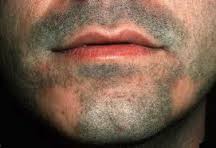Tinea capitis.
Tinea capitis, commonly known as ringworm, is a
fungal infection often seen in children. It can show up in a number of ways,
but the most common is as scaly patches of hair loss on the head. The patches
are usually round or oval. The hairs can be broken off at the surface of the skin and look like black dots on the scalp.
If your child's doctor suspects
tinea capitis, a culture can confirm the diagnosis. Treatment may involve an
oral antifungal and or an antifungal shampoo to decrease shedding of the
fungus.
Because ringworm is contagious, your child should be careful not to share any objects that touch the head, such as hats, pillow-cases or brushes.
Because ringworm is contagious, your child should be careful not to share any objects that touch the head, such as hats, pillow-cases or brushes.
Alopecia areata. Alopecia areata is a condition of hair loss thought to be
caused by the body's immune system attacking the hair follicles. It is characterised
by the sudden appearance of round or oval patches of hair loss. The patches are
slick or smooth, without scaling or broken hairs.
About 25% of children with this condition also have pitting and ridging of the nails.
About 25% of children with this condition also have pitting and ridging of the nails.
While there is no cure for alopecia
areata, treatment can control the disease in some children.
Many have their hair back within a year. However, for about 5% of children, the disease progresses to alopecia totalis - the loss of all of the hair on the scalp. Some of these children will develop alopecia universalis - a total loss of body hair.
For younger children, treatment consists
primarily of strong corticosteroid ointments or creams applied to the bald
areas. Teenagers, who may be sufficiently motivated to have their hair return, Many have their hair back within a year. However, for about 5% of children, the disease progresses to alopecia totalis - the loss of all of the hair on the scalp. Some of these children will develop alopecia universalis - a total loss of body hair.



